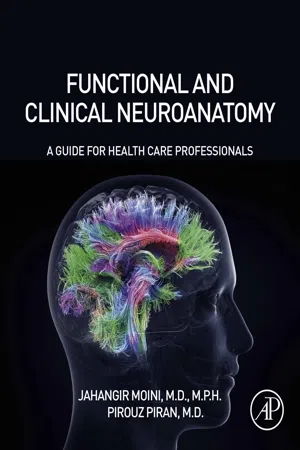Biological Sciences
Cranial Nerves
Cranial nerves are a set of 12 pairs of nerves that emerge directly from the brain and brainstem. They are responsible for controlling various functions such as sensation, movement, and autonomic activities in the head and neck. Each cranial nerve has specific functions and innervates specific areas, playing a crucial role in the overall functioning of the nervous system.
Written by Perlego with AI-assistance
Related key terms
6 Key excerpts on "Cranial Nerves"
- eBook - ePub
Functional and Clinical Neuroanatomy
A Guide for Health Care Professionals
- Jahangir Moini, Pirouz Piran(Authors)
- 2020(Publication Date)
- Academic Press(Publisher)
olfactory nerve (I) .Every cranial nerve is attached to the brain adjacent to its associated nuclei, whether sensory, motor, or both. For the sensory nuclei, postsynaptic neurons relay information to other nuclei, or to centers in the cerebral cortex or cerebellar cortex, for processing. Motor nuclei information is similarly processed, as they receive input from higher brain centers, or from various nuclei found along the brainstem.The Cranial Nerves are classified as follows:- • Mostly sensory —carrying somatic sensory information (pressure, touch, temperature, vibration, pain) or special sensory, such as sight, hearing, balance, and smell
- • Motor —dominated by axons of somatic motor neurons
- • Mixed (sensory and motor) —a mixture of sensory and motor fibers
Cranial Nerves III, VII, IX, and X also contribute to the parasympathetic autonomic system. The 12 pairs of Cranial Nerves connect to the under portion of the brain, primarily on the brainstem (see Fig. 10.1 ). They pass through small holes called foramina in the cranial cavity within the skull. This allows them to extend between the brain and their peripheral connections. It is important to note that the sensory fibers of the Cranial Nerves are termed proprioceptive .Fig. 10.1 - Wanda Webb, Richard K. Adler(Authors)
- 2016(Publication Date)
- Mosby(Publisher)
7The Cranial Nerves
To those I address, it is unnecessary to go further than to indicate that the nerves treated in these papers are the instruments of expression from the smile of the infant’s cheek to the last agony of life.Charles Bell, 1824Chapter OutlineOrigin of the Cranial Nerves Names and Numbers Embryologic Origin The Corticonuclear Tract and the Cranial Nerves Cranial Nerves for Smell and Vision Cranial Nerves for Speech and Hearing Cranial Nerve V: Trigeminal Cranial Nerve VII: Facial Cranial Nerve VIII: Acoustic-Vestibular or Vestibulocochlear Cranial Nerve IX: Glossopharyngeal Cranial Nerve X: Vagus Cranial Nerve XI: Spinal Accessory Cranial Nerve XII: Hypoglossal Instrumental Measurement of Strength Cranial Nerve Cooperation: The Act of Swallowing Assessment of SwallowingKey Termsabducens abduction branchial central pattern generator chorda tympani Cranial Nerves diplopia flaccid genioglossus glottal coup hyoglossus internuncial lacrimal palpate primary olfactory cortex ptosis secretomotor solely special sensory styloglossus tinnitusThis chapter is intended to help the speech-language pathologist (SLP) understand one of the most important components of the nervous system in regard to the acts of hearing, speaking and swallowing. The Cranial Nerves comprise a part of the peripheral nervous system that provides crucial sensory and motor information for the oral, pharyngeal, and laryngeal musculature and the auditory and vestibular systems. The speech-language pathologist should be familiar with the names, structure, innervation, testing procedures, and signs of abnormal function of the Cranial Nerves. This information is especially critical when working with an adult or child with dysarthria and/or dysphagia.Origin of the Cranial Nerves
Names and Numbers
Twelve pairs of Cranial Nerves leave the brain and pass through the foramina of the skull. They are referred to by their numbers, written in Roman numerals, and by their names. The names sometimes give a clue to the function of the nerves, but the number, name, and concise descriptions of the various functions should all be learned (Table 7-1 ). Many students use a suggested mnemonic device to help them remember the Cranial Nerves (e.g., “O n O ld O lympus’ T owering T op A F inn A nd G erman V end A t H- Robert L. Maynard, Noel Downes(Authors)
- 2019(Publication Date)
- Academic Press(Publisher)
Chapter 21Peripheral Nervous System
Chapter 21.1Cranial Nerves
Making Sense of the Cranial Nerves
Various Cranial Nerves are mentioned in the other chapters of this book; in this chapter, we treat them as a group and try to discover some underlying principles that explain their complexity. The search for such principles has been underway since the late 19th century. Balfour, in 1885 , demonstrated that the head of vertebrates was segmented in the same way as the rest of the body. Once this was established it seemed safe to assume that the Cranial Nerves should follow a pattern similar to that of the spinal nerves, with each cranial nerve associated with a particular segment. The segments were named from premandibular at the front of the skull, to the obvious occipital segments at the back. Thinking along these lines can be traced through the works of Goodrich (1930) , De Beer (1951) and Young (1962) , and represents an important aspect of classical comparative anatomy.This linking of Cranial Nerves with segments might be regarded as the first of four lines of attack on the problem of making sense of the Cranial Nerves, although recent work has shown that segmentation of the head is more complex than first thought.A second line of attack involves examination of the Cranial Nerves in terms of whether they represent dorsal or ventral roots of segmental nerves. Each spinal nerve has a dorsal and a ventral root which join just as the nerve leaves the vertebral column. The dorsal root is distinguished by the presence of a dorsal root ganglion where the cell bodies of the afferent neurones reside. These neurones carry sensory information from the periphery to the spinal cord. The ventral roots carry the motor fibres that travel in the opposite direction.- eBook - ePub
- Ruth Hull(Author)
- 2021(Publication Date)
- Lotus Publishing(Publisher)
The Cranial Nerves are considered part of the PNS. There are 12 pairs of them, 10 which originate from the brain stem and 2 which originate inside the brain. They are named according to their distribution or function and numbered according to where they arise in the brain (in order from anterior to posterior).Most of the Cranial Nerves contain both motor and sensory fibres and so are mixed nerves. Only three are purely sensory: the olfactory, optic and vestibulocochlear nerves.Figure 6.14 An overview of the brain and Cranial NervesCranial Nerves Number Name Function I Olfactory Smell II Optic Vision III Oculomotor Motor function: Movement of eyelid and eyeball; control of lens shape and pupil sizeSensory function: Proprioception in eyeball musclesIV Trochlear Motor function: Movement of eyeballSensory function : Proprioception in superior oblique muscle of the eyeballV Trigeminal – has three branches: the ophthalmic, maxillary and mandibular branches Motor function: ChewingSensory function: Sensations of touch, pain and temperature from the skin of the face and the mucosa of the nose and mouth, and sensations supplied by proprioceptors in the muscles of masticationVI Abducens Motor function: Movement of eyeballSensory function: Proprioception in lateral rectus muscle of the eyeballVII Facial – has five branches: the temporal, zygomatic, buccal, mandibular and cervical branches Motor function: - eBook - ePub
- Richard S. Snell, Michael A. Lemp(Authors)
- 2013(Publication Date)
- Wiley-Blackwell(Publisher)
The Cranial Nerves described in this chapter are the olfactory, facial, vestibulocochlear, glossopharyngeal, vagus, accessory, and hypoglossal nerves. The olfactory and vestibulocochlear nerves are entirely sensory in function. The accessory and hypoglossal nerves are entirely motor in function. The facial, glossopharyngeal, and vagus nerves are both motor and sensory. Because these nerves are not directly associated with the eye and orbit, only a brief account of each nerve is given here. The different components of the Cranial Nerves, their functions, and the openings in the skull through which the nerves leave the cranial cavity are summarized in Table 10-2.The Sensory Nerves
Olfactory Nerves (Cranial Nerve I)
The olfactory nerves are responsible for conducting the sensations of smell from the upper part of the nasal mucous membrane to the olfactory bulbs in the skull.Origin and Course
The olfactory nerves arise from the olfactory receptor nerve cells in the olfactory mucous membrane located in the upper part of the nasal cavity above the level of the superior concha (Fig. 11-1 ). The olfactory receptor cells are scattered among supporting cells. Each receptor cell consists of a small bipolar nerve cell with a coarse peripheral process that passes to the surface of the membrane and a fine central process. From the coarse peripheral process a number of short cilia, the olfactory hairs, arise and project into the mucus covering the surface of the mucous membrane. These projecting hairs react to odors in the air and stimulate the olfactory cells.The fine central processes form the olfactory nerve fibers (Fig. 11-1 ). Bundles of these nerve fibers pass through the openings of the cribriform plate of the ethmoid bone to enter the olfactory bulb inside the skull.Central Connections
Olfactory Bulbs
This ovoid structure lies in the anterior cranial fossa and possesses several types of nerve cells including the large mitral cell (Fig. 11-1 - David Sturgeon(Author)
- 2018(Publication Date)
- Routledge(Publisher)
Chapter 4 ), the bones are able to expand to accommodate the excess fluid to some extent. Treatment normally involves inserting a tube called a shunt into one of ventricles to drain the CSF. The shunt contains a valve to ensure the fluid only travels in one direction (i.e. out of the brain and into the venous circulation).Chapter 12: Test YourselfQ. The nervous system can be broadly divided into the central nervous system (CNS) and the peripheral nervous system. What is the difference between the two?A. The CNS consists of the brain and the spinal cord (attached to one another at the base of the brainstem). The peripheral nervous system refers to the nerves of the body that are not part of the CNS, including 31 pairs of spinal nerves.Q. How many pairs of cervical, thoracic, lumber, sacral and coccygeal nerves are there?A. 8 cervical, 12 thoracic, 5 lumber, 5 sacral and 1 coccygeal.Q. How many Cranial Nerves are there?A. Twelve.Q. What is the difference between motor (efferent) and sensory (afferent) nerves?A. Motor nerves travel away from the CNS and coordinate movement. Sensory nerves travel towards the CNS and relay information toward the brain for interpretation or, in the case of reflexes, towards a corresponding motor nerve via the spinal cord.Q. What is the function of the axon hillock and axon in a neuron?A. The axon hillock is a small elevation situated between the cell body and the axon. It triggers the creation of a nerve impulse (action potential) that is driven along the length of the axon towards the synaptic terminals.Q. Most axons are surrounded by a sheath of fatty material called myelin. What does myelin do?A. Myelin insulates the axon and helps to increase the speed of nerve transmission along its length.Q. What is the function of a synapse and a neurotransmitter?A.
Learn about this page
Index pages curate the most relevant extracts from our library of academic textbooks. They’ve been created using an in-house natural language model (NLM), each adding context and meaning to key research topics.





